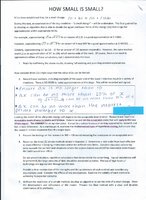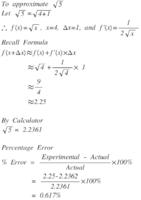eldoubleu02
New member
- Joined
- Aug 20, 2019
- Messages
- 9
Hey everyone
I am currently studying senior mathematics (year 12) in Queensland, Australia.
I take the subject Mathematics C which is the highest level math subject that you can study.
At this present time I am writing an assignment on small change and methods to set a limit to small change.
The final question of this assignment asks for us to...
Without the restriction of a simple method, develop an algorithm to set the limit of a small change. Show the development and refinement of the model. Present the final method with a clear and detailed method of its attributes.
The final goal of the task is to be able to develop an algorithm that is able to decide the upper and lower limits of the change (delta x) that keeps an approximation (approximating roots eg. √5 = √4+1) within appropriate limits.
The task so far has been based around approximating roots (as shown above) so I am assuming that this will come into play when developing the algorithm. We also had to decide on an appropriate amount of percentage error [(approx roots value - calculator value)/calculator value] and this has been decided as +- 3%.
I'm really stuck on this final question and could use some help!
Thanks so much guys...any more questions don't hesitate to ask.
El
I am currently studying senior mathematics (year 12) in Queensland, Australia.
I take the subject Mathematics C which is the highest level math subject that you can study.
At this present time I am writing an assignment on small change and methods to set a limit to small change.
The final question of this assignment asks for us to...
Without the restriction of a simple method, develop an algorithm to set the limit of a small change. Show the development and refinement of the model. Present the final method with a clear and detailed method of its attributes.
The final goal of the task is to be able to develop an algorithm that is able to decide the upper and lower limits of the change (delta x) that keeps an approximation (approximating roots eg. √5 = √4+1) within appropriate limits.
The task so far has been based around approximating roots (as shown above) so I am assuming that this will come into play when developing the algorithm. We also had to decide on an appropriate amount of percentage error [(approx roots value - calculator value)/calculator value] and this has been decided as +- 3%.
I'm really stuck on this final question and could use some help!
Thanks so much guys...any more questions don't hesitate to ask.
El



